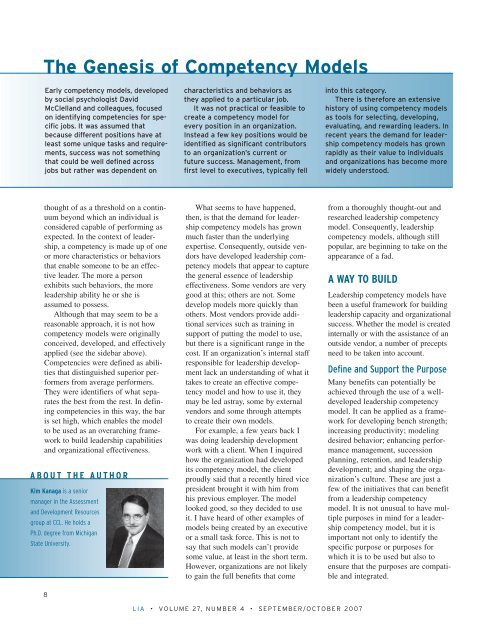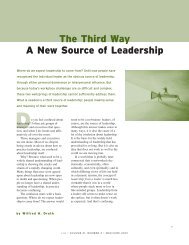Performance Test: Designing an Effective Competency Model ...
Performance Test: Designing an Effective Competency Model ...
Performance Test: Designing an Effective Competency Model ...
Create successful ePaper yourself
Turn your PDF publications into a flip-book with our unique Google optimized e-Paper software.
The Genesis of <strong>Competency</strong> <strong>Model</strong>s<br />
Early competency models, developed<br />
by social psychologist David<br />
McClell<strong>an</strong>d <strong>an</strong>d colleagues, focused<br />
on identifying competencies for specific<br />
jobs. It was assumed that<br />
because different positions have at<br />
least some unique tasks <strong>an</strong>d requirements,<br />
success was not something<br />
that could be well defined across<br />
jobs but rather was dependent on<br />
characteristics <strong>an</strong>d behaviors as<br />
they applied to a particular job.<br />
It was not practical or feasible to<br />
create a competency model for<br />
every position in <strong>an</strong> org<strong>an</strong>ization.<br />
Instead a few key positions would be<br />
identified as signific<strong>an</strong>t contributors<br />
to <strong>an</strong> org<strong>an</strong>ization’s current or<br />
future success. M<strong>an</strong>agement, from<br />
first level to executives, typically fell<br />
into this category.<br />
There is therefore <strong>an</strong> extensive<br />
history of using competency models<br />
as tools for selecting, developing,<br />
evaluating, <strong>an</strong>d rewarding leaders. In<br />
recent years the dem<strong>an</strong>d for leadership<br />
competency models has grown<br />
rapidly as their value to individuals<br />
<strong>an</strong>d org<strong>an</strong>izations has become more<br />
widely understood.<br />
thought of as a threshold on a continuum<br />
beyond which <strong>an</strong> individual is<br />
considered capable of performing as<br />
expected. In the context of leadership,<br />
a competency is made up of one<br />
or more characteristics or behaviors<br />
that enable someone to be <strong>an</strong> effective<br />
leader. The more a person<br />
exhibits such behaviors, the more<br />
leadership ability he or she is<br />
assumed to possess.<br />
Although that may seem to be a<br />
reasonable approach, it is not how<br />
competency models were originally<br />
conceived, developed, <strong>an</strong>d effectively<br />
applied (see the sidebar above).<br />
Competencies were defined as abilities<br />
that distinguished superior performers<br />
from average performers.<br />
They were identifiers of what separates<br />
the best from the rest. In defining<br />
competencies in this way, the bar<br />
is set high, which enables the model<br />
to be used as <strong>an</strong> overarching framework<br />
to build leadership capabilities<br />
<strong>an</strong>d org<strong>an</strong>izational effectiveness.<br />
ABOUT THE AUTHOR<br />
Kim K<strong>an</strong>aga is a senior<br />
m<strong>an</strong>ager in the Assessment<br />
<strong>an</strong>d Development Resources<br />
group at CCL. He holds a<br />
Ph.D. degree from Michig<strong>an</strong><br />
State University.<br />
What seems to have happened,<br />
then, is that the dem<strong>an</strong>d for leadership<br />
competency models has grown<br />
much faster th<strong>an</strong> the underlying<br />
expertise. Consequently, outside vendors<br />
have developed leadership competency<br />
models that appear to capture<br />
the general essence of leadership<br />
effectiveness. Some vendors are very<br />
good at this; others are not. Some<br />
develop models more quickly th<strong>an</strong><br />
others. Most vendors provide additional<br />
services such as training in<br />
support of putting the model to use,<br />
but there is a signific<strong>an</strong>t r<strong>an</strong>ge in the<br />
cost. If <strong>an</strong> org<strong>an</strong>ization’s internal staff<br />
responsible for leadership development<br />
lack <strong>an</strong> underst<strong>an</strong>ding of what it<br />
takes to create <strong>an</strong> effective competency<br />
model <strong>an</strong>d how to use it, they<br />
may be led astray, some by external<br />
vendors <strong>an</strong>d some through attempts<br />
to create their own models.<br />
For example, a few years back I<br />
was doing leadership development<br />
work with a client. When I inquired<br />
how the org<strong>an</strong>ization had developed<br />
its competency model, the client<br />
proudly said that a recently hired vice<br />
president brought it with him from<br />
his previous employer. The model<br />
looked good, so they decided to use<br />
it. I have heard of other examples of<br />
models being created by <strong>an</strong> executive<br />
or a small task force. This is not to<br />
say that such models c<strong>an</strong>’t provide<br />
some value, at least in the short term.<br />
However, org<strong>an</strong>izations are not likely<br />
to gain the full benefits that come<br />
from a thoroughly thought-out <strong>an</strong>d<br />
researched leadership competency<br />
model. Consequently, leadership<br />
competency models, although still<br />
popular, are beginning to take on the<br />
appear<strong>an</strong>ce of a fad.<br />
A WAY TO BUILD<br />
Leadership competency models have<br />
been a useful framework for building<br />
leadership capacity <strong>an</strong>d org<strong>an</strong>izational<br />
success. Whether the model is created<br />
internally or with the assist<strong>an</strong>ce of <strong>an</strong><br />
outside vendor, a number of precepts<br />
need to be taken into account.<br />
Define <strong>an</strong>d Support the Purpose<br />
M<strong>an</strong>y benefits c<strong>an</strong> potentially be<br />
achieved through the use of a welldeveloped<br />
leadership competency<br />
model. It c<strong>an</strong> be applied as a framework<br />
for developing bench strength;<br />
increasing productivity; modeling<br />
desired behavior; enh<strong>an</strong>cing perform<strong>an</strong>ce<br />
m<strong>an</strong>agement, succession<br />
pl<strong>an</strong>ning, retention, <strong>an</strong>d leadership<br />
development; <strong>an</strong>d shaping the org<strong>an</strong>ization’s<br />
culture. These are just a<br />
few of the initiatives that c<strong>an</strong> benefit<br />
from a leadership competency<br />
model. It is not unusual to have multiple<br />
purposes in mind for a leadership<br />
competency model, but it is<br />
import<strong>an</strong>t not only to identify the<br />
specific purpose or purposes for<br />
which it is to be used but also to<br />
ensure that the purposes are compatible<br />
<strong>an</strong>d integrated.<br />
8<br />
LIA • VOLUME 27, NUMBER 4 • SEPTEMBER/OCTOBER 2007





